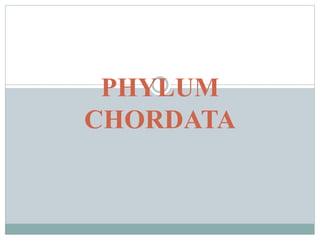
Phylum chordata - zoology
- 2. Characteristics of Phylum Chordata 1. A notochord 2. A dorsal hollow nerve cord 3. Pharyngeal slits 4. Post-anal tail
- 3. Notochord The chordates are named for the notochord: a flexible, rod- shaped structure that is found in the embryonic stage of all chordates and also in the adult stage of some chordate species. It is located between the digestive tube and the nerve cord, providing skeletal support through the length of the body. In some chordates, the notochord acts as the primary axial support of the body throughout the animal's lifetime.
- 4. In vertebrates, the notochord is present during embryonic development, at which time it induces the development of the neural tube which serves as a support for the developing embryonic body. The notochord, however, is replaced by the vertebral column (spine) in most adult vertebrates.
- 5. Dorsal Hollow Nerve Cord The dorsal hollow nerve cord derives from ectoderm that rolls into a hollow tube during development. In chordates, it is located dorsally (at the top of the animal) to the notochord. In contrast to the chordates, other animal phyla are characterized by solid nerve cords that are located either ventrally or laterally. The nerve cord found in most chordate embryos develops into the brain and spinal cord, which comprise the central nervous system.
- 7. Pharyngeal Slits Pharyngeal slits are openings in the pharynx (the region just posterior to the mouth) that extend to the outside environment. In organisms that live in aquatic environments, pharyngeal slits allow for the exit of water that enters the mouth during feeding. Some invertebrate chordates use the pharyngeal slits to filter food out of the water that enters the mouth. In vertebrate fishes, the pharyngeal slits develop into gill arches, the bony or cartilaginous gill supports.
- 8. In most terrestrial animals, including mammals and birds, pharyngeal slits are present only during embryonic development. In these animals, the pharyngeal slits develop into the jaw and inner ear bones.
- 9. Post-Anal Tail The post-anal tail is a posterior elongation of the body, extending beyond the anus. The tail contains skeletal elements and muscles, which provide a source of locomotion in aquatic species. In some terrestrial vertebrates, the tail also helps with balance, courting, and signaling when danger is near. In humans and other apes, the post-anal tail is present during embryonic development, but is vestigial as an adult.
- 10. CLASSIFICATION
- 13. Protochordata They are primitive chordates without head and vertebral column. Subphylum are as follows :- 1. UROCHORDATA- sedentary or planktonic tunicates in which chordate characters manifest in the larval stage. Eg: Herdmania, Salpa, Doliolum, Pyrosoma, Oikopleura 2. CEPHALOCHORDATA- typical chordates having chordate characters in the larval as well as adult stage. Eg: Amphioxus, Asymmetron
- 14. Euchordata They are true chordates. Subphylum include vertebrata Superclass are as follows :- 1. AGNATHA 2. GNATHOSTOMATA
- 15. Agnatha It includes 90 species of paraphyletic group of jawless fishes, which were also the first vertebrates. Living forms are elongated, scaleless, slimy parasites and scavengers that include lampreys and hagfishes. They have no paired fins. Class:-
- 16. 1. OSTRACODERMI- extinct shelled jawless fishes of Ordovician period. Eg: Cephalaspsis 2. CYCLOSTOMATA- jawless fishes of today, without scales and paired fins. Eg: Myxine, Bdellostoma, Petromyzon
- 17. Gnathostomata It includes vertebrates with jaws and have modified gill arches and paired appendages. They include pisces and tetrapods.
- 18. Fishes A fish is any member of a paraphyletic group of organisms that consist of all gill-bearing aquatic craniate animals that lack limbs with digits. Class includes :- 1. CHONDRICHTHYES – cartilaginous fishes that have cartilaginous skeleton, ventral mouth, placoid scales, heterocercal tail fin and 5 pairs of gill slits. Eg: Chimaeras 2. OSTEICHTHYES – 20,000 species, bony fishes. Skeleton contains bone, four pairs of gills, covered with operculum. Possess swim bladder or lungs. Eg: Tuna, eel
- 20. TETRAPODS Comprises the four-limbed vertebrates and their descendants. Class include :- 1. Class AMPHIBIA- Eg: Frog, Salamander 2. Class REPTILIA- Snake, Turtle 3. Class AVES- Eg: Owl, Eagle 4. Class MAMMALIA- Eg: Human, Lion
- 21. THANK YOU
Editor's Notes
- A flexible rodlike structure that forms the main support of the body in the lowest chordates; a primitive spine The series of vertebrae, separated by disks, that encloses and protects the spinal cord, and runs down the middle of the back in vertebrate animals.
- In humans, the first pair of pouches becomes the tonsils, while the third and fourth pairs become the thymus and parathyroid glands. Embryologist and evolutionist Michael Richardson and colleagues dropped a bomb on Haeckel's long-held concept known as "embryonic recapitulation." He compared Haeckel's old drawings with actual photographs of the same embryos in a 1997 technical paper.1 The comparison showed that Haeckel's drawings were frauds.
- Tuinicate :a marine invertebrate of a group which includes the sea squirts and salps. They have a rubbery or hard outer coat and two siphons to draw water into and out of the body.
- Paraphyletic: descended from a common evolutionary ancestor or ancestral group, but not including all the descendant groups.
- The Ordovician Period lasted almost 45 million years, beginning 488.3 million years ago and ending 443.7 million years ago.
- ) tooth-like, being made of dentine with a pointed backward projection of enamel, as in sharks and rays. Heteroceral having unequal upper and lower lobes, usually with the vertebral column passing into the upper.
